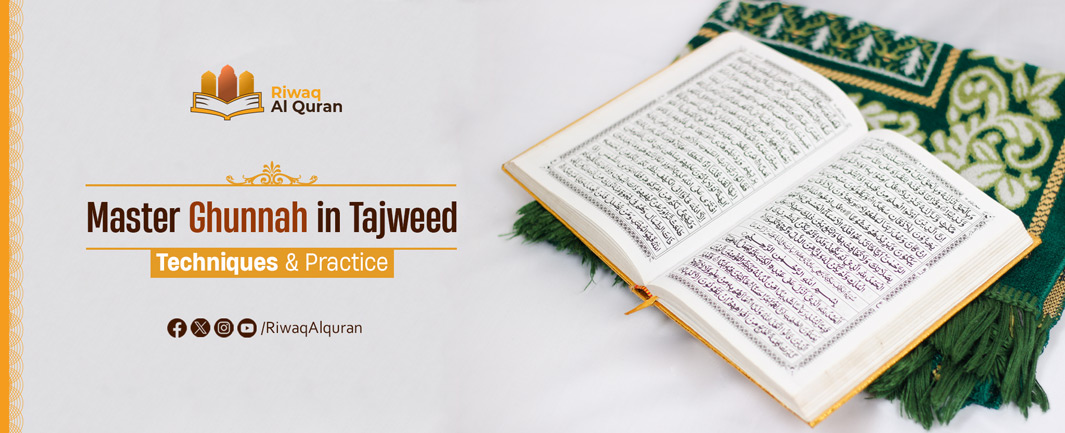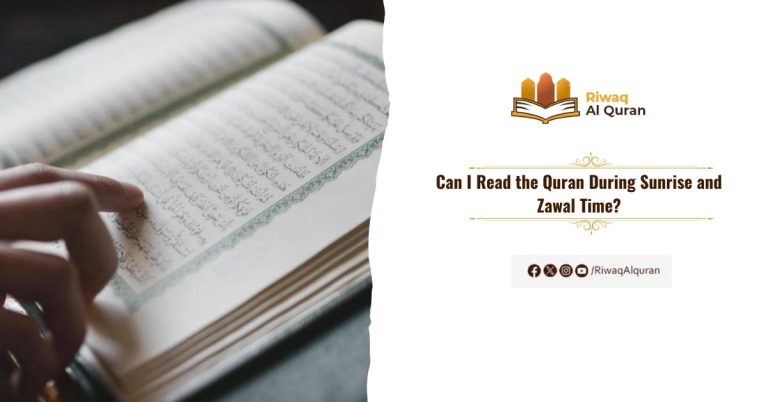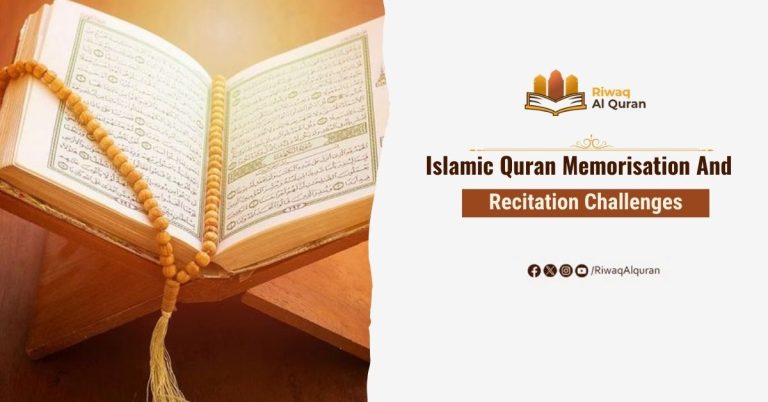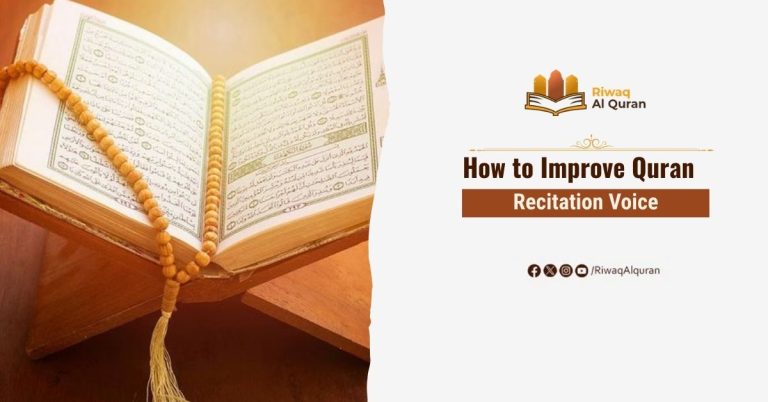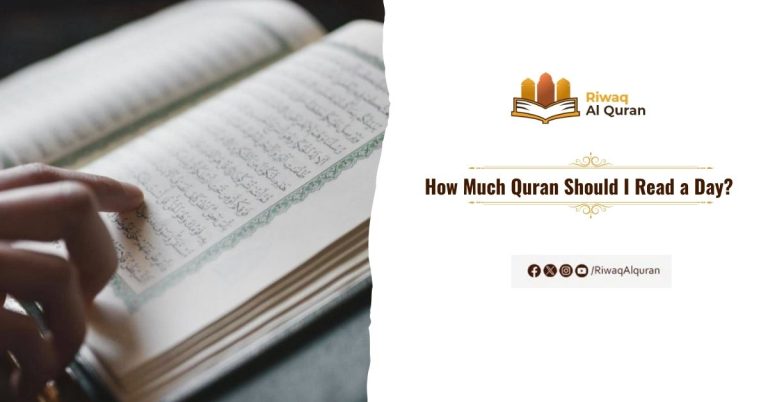In a Nutshell: Ghunnah, an intrinsic nasal sound, is unique to the Arabic letters ن (Noon) and م (Meem), resonating from the nose regardless of their state (voweled, silent, or doubled). Its mastery, crucial in Tajweed, requires precise timing (two counts), balanced emphasis, and seamless articulation during rules like Ikhfaa, Idgham, and Iqlaab. Examples include إِنَّا (Surah Al-Kawthar) and مِن بَعْدِ (Surah Al-Baqarah). Perfect your recitation through consistent practice and expert guidance—enroll in online Tajweed classes today!
When one recites the Quran, Allah takes note of the time and effort that his servants exert to read His message, even if they never achieve perfection. In this blog, we’ll cover a specific type of technique called Ghunnah to recite the Quran with the correct pronunciation. So, let’s now dive deeper into the application of Ghunnah, its letters, and examples from the Quran.
Table of Contents
What Does Ghunnah Mean in Arabic?
The linguistic definition is a sound generated from the nasal passage with no function of the tongue. Coming to its applied definition, Ghunnah in English means an unconditional nasalized sound fixed on the Arabic letter ن, even if it is a tanween and the م. This indicates that it is an inherent sound in the ن and م whether they have a vowel or not.
What Is Ghunnah in Tajweed?
Ghunnah (غُنَّة) is indeed a nasalized sound that emanates from the nose, and it is an intrinsic characteristic of the Arabic letters ن (Noon) and م (Meem). This quality remains consistent regardless of whether these letters are:
- Voweled (having Harakat like Fatha, Damma, or Kasra).
- Silent (as in cases of Sukoon or Shaddah).
How to Do Ghunnah?
It is a nasalized sound that falls between a hum and a moan.
What Are the Letters of Ghunnah?
Ghunnah letters in Arabic are ن and م, where ن (noon) includes a tanween.
Importance of learning Ghunnah in Tajweed:
Learning Tajweed, including Ghunnah, is crucial – it beautifies the recitation, along with ensuring the message is not distorted by mistake. Reciting Quranic verses without Tajweed could alter the meaning of words since there are rules defined to differentiate similar letters. In a similar way, incorrect elongations can change the meaning.
Reading the Quran benefits the readers in different ways. Here is one particular hadith that explains the reward of reciting the holy verses beautifully. Aishah (May Allah SWT be pleased with her) said:
Allah’s Messenger (PBUH) said,” The one who is an expert in the recitation of the Holy Quran will be with the obedient and honorable scribes (angels), and he who recites the Holy Quran and finds it hard to recite, doing his best to recite in the best possible manner, will have two rewards.” [Al-Bukhari and Muslim]
Makhraj of Ghunnah in Tajweed:
To better understand Ghunnah, let’s first learn about Makharij. Makharij refers to the articulation points of Arabic letters, which are the specific areas in the mouth, throat, and nasal passages where the sound of each letter is produced. Some letters, like noon and meem, involve Ghunnah, which is the nasal sound produced during their articulation.
1. Noon Makhraj for Ghunnah
The makhraj of the letter ن (noon) is from the tip of the tongue placed against the front of the upper palate, just behind the upper teeth. When pronouncing noon, Ghunnah is applied, producing a distinct nasal sound. The air passes through the nose, which is a defining feature of noon and its nasal sound.
2. Meem Makhraj for Ghunnah
The makhraj of the letter م (meem) is from the lips, where the upper and lower lips come together. Just like noon, Ghunnah is involved when pronouncing meem.. The air passes through the nasal passage, creating the characteristic nasal sound, which makes meem a soft yet distinct letter with a clear nasal resonance.
What Are the Letters of Ghunnah?
Ghunnah Letters are specific Arabic letters that require the production of a nasal sound during recitation, especially under certain Tajweed rules. Below are the details for each of these letters and their associated rules:
1. (Noon – ن)
The letter ن (Noon) requires Ghunnah when it appears with rules like Ikhfaa, Idgham, or Iqlaab. The nasal sound is prolonged for two counts.
2. (Meem – م)
The letter م (Meem) requires Ghunnah when it appears in situations like Ikhfaa Shafawi or Idgham Shafawi, also with a duration of two counts.
Ghunnah Rules:
It is a nasalized sound that falls between a hum and a moan. The following considerations help in applying the Ghunnah rule correctly:
1. Two Harakahs Duration
The Ghunnah sound is extended for two harakahs (two counts) when applied. This duration ensures the nasal sound is neither too short nor too long. It helps maintain a smooth and balanced flow in recitation, which is essential for accurate Tajweed.
2. Maintain Proper Nasal Sound
The ghunnah must be produced from the nasal passage, creating a smooth, continuous sound. It should not be harsh or forced. Proper nasal resonance is necessary to achieve the correct tone while adhering to the rules of Tajweed.
3. Correct Letter Merging
When certain letters like Noon (ن) or Meem (م) are followed by letters requiring idgham (merging), ensure the ghunnah is pronounced during this merging. The nasal sound should flow seamlessly between the two letters. This step is crucial for maintaining clarity in recitation.
4. Avoid Overemphasis
While ghunnah is required, it should not be exaggerated. Overemphasizing the nasal sound can disrupt the recitation and affect the quality. Maintaining balance ensures the correct pronunciation without distorting the intended meaning of the words.

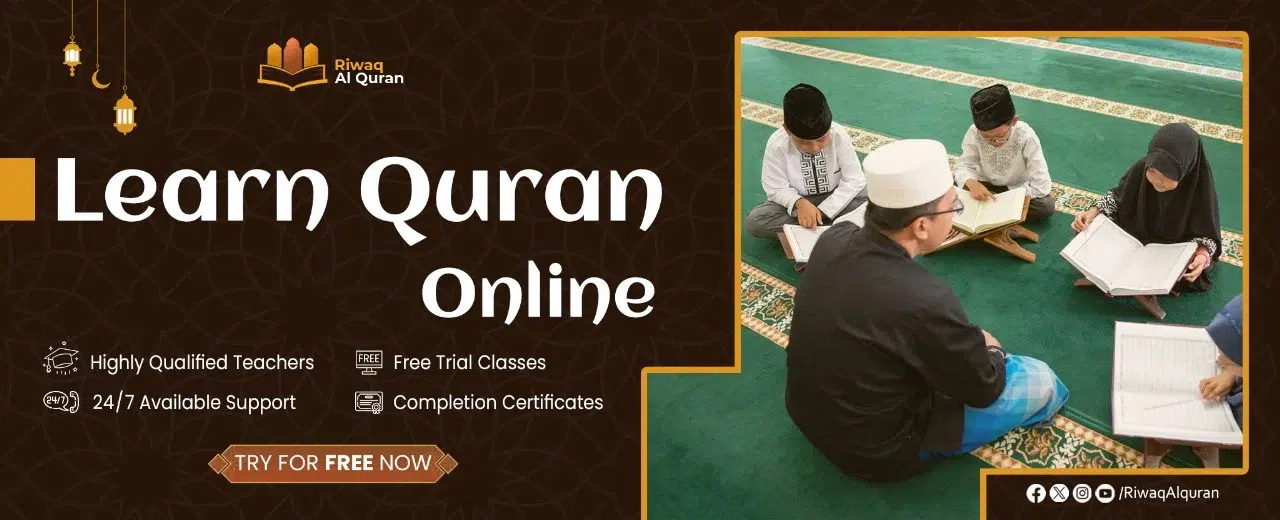
Experience Riwaq Al Quran Classes
Watch real moments from our live sessions at Riwaq Al Quran and see how we bring learning to life. These clips highlight our interactive, student-focused approach designed to keep learners engaged, motivated, and actively involved in every step of their educational journey.
Types of Ghunnah
There are four types of Ghunnah, depending on their level. Wajib Ghunnah refers to the nasal sound that is mandatory in certain conditions in Tajweed. It has four types, categorized by their levels of completeness and intensity:
1. Most Complete Ghunnah (أكمل)
Occurs in the shaddah (doubled) and merged (mudgham) forms of Noon and Meem. This level has the strongest and clearest ghunnah, making it highly emphasized in recitation. It is considered the most perfect form of ghunnah due to its intensity.
- من وَلِي (Surah Al-Baqarah, Ayah 255)
- كَمْ مِن (Surah Aal-e-Imran, Ayah 124)
- النَّاسِ (Surah Aal-e-Imran, Ayah 110)
2. Complete Ghunnah (كاملة)
Occurs in the hidden (mukhfaa) Noon and Meem. Found in true ikhfa, oral ikhfa (ikhfa shafawi), and qalb (transformation). The ghunnah here is slightly less intense than the first level but still holds significant emphasis during recitation.
- هُمْ بَارِزُونَ (Surah Al-Mu’minun, Ayah 109)
- مَنْثُورًا (Surah Qaf, Ayah 8)
3. Incomplete Ghunnah (ناقصة)
Occurs in the Noon and Meem with sukoon (static) that are clearly pronounced. Found in throat-clear (izhar halqi) and oral clear (izhar shafawi) articulation. The ghunnah in this level is weaker, as it does not involve the same intensity as in the previous levels.
- أَنْعَمْتَ (Surah Al-Fatiha, Ayah 7)
- الدُّنْيَا (Surah Aal-e-Imran, Ayah 14)
4. Most Incomplete Ghunnah (أنقص)
Occurs in the moving (mutaharrik) Noon and Meem. This level has the weakest form of ghunnah, as the movement of the letters reduces its prominence. It is the least noticeable and requires the least amount of emphasis.
- نَمَارِقَ (Surah Al-Ghashiyah, Ayah 15)
Ghunnah Examples from the Quran
These examples demonstrate how Ghunnah is applied in various Tajweed rules in the Quran. Here are some of the many examples of Ghunnah from the Quran:
- إِنَّا (Surah Al-Kawthar, 108:1) – Noon Mushaddadah
- ثُمَّ (Surah At-Takathur, 102:7) – Meem Mushaddadah
- مَن يَعْمَلْ (Surah Al-Zalzalah, 99:7) – Idgham with Ghunnah
- وُجُوهٌ يَوْمَئِذٍ (Surah Al-Qiyamah, 75:22) – Idgham with Ghunnah
- مِن بَعْدِ (Surah Al-Baqarah, 2:27) – Iqlaab
- أَنبِئْهُمْ (Surah Al-Baqarah, 2:33) – Iqlaab
- مِن ثَمَرَةٍ (Surah Al-Baqarah, 2:266) – Ikhfa
- عَذَابٍ قَرِيبٍ (Surah Saba’, 34:51) – Ikhfa
- فَمَن يَعْمَلْ (Az-Zalzalah: 7) – Idgham with Ghunnah
- اِنَّ الۡاِنۡسَانَ لَفِىۡ خُسۡرٍۙ (Al-Asr: 2) Noon Mushaddad and Ikhfa
- مِّن سِجِّيلٍۢ (Al-Fil: 4) Ikhfa
Idghaam with Ghunnah Examples
Idghaam of Noon Sakinah and Tanween is among the most important Tajweed rules that we all should recite the Quran with. There are two types of Idghaam. The one that we are going to cover in this post is Idgham with Ghunnah. This happens when any of these letters (ي، ن، م، و) follows Noon Sakinah or Tanween.
Their joining with Ghunnah letters happens in two groups. The first one is Full Idghaam – it indicates that the humming is quite powerful than it would be if the lesser one was generated. This is mostly used with letters (ن، م). The second one is sounded for two counts, like the time it takes to say the words “one-two”.
How to Learn Ghunnah Rules Effectively?
Mastering Ghunnah not only beautifies your recitation but also ensures proper application of Tajweed rules. Here’s how you can learn it effectively:
1. Understand the Basics of Ghunna
Ghunna is a nasal sound produced when reciting certain letters like Noon (ن) and Meem (م). It occurs in specific situations such as sukun, tanween, or during idgham (merging). This nasal sound is essential for correct Tajweed and ensures the clarity and beauty of the Quranic recitation, which is a focus at Riwaq Al Quran.
2. Familiarize Yourself with Letters Requiring Ghunna
The letters that require ghunnah are: Noon (ن), Meem (م), and in some cases Waw (و) and Ya (ي), especially in idgham. Understanding these letters and their conditions for ghunnah is crucial in achieving a perfect recitation, as taught at Riwaq Al Quran.
3. Practice Consistently
Daily practice is essential for mastering ghunnah. Focus on reciting verses that contain tanween, sukun, or idgham to reinforce your skills. Riwaq Al Quran offers consistent support through its online sessions, helping students practice regularly.
4. Correct Mistakes Early
Pay attention to the length of the nasal sound. Avoid making the sound too long or too short, as this can affect the quality of your recitation. With the help of Riwaq Al Quran’s detailed feedback, you can quickly identify and correct mistakes in your recitation.
5. Recite Slowly and Clearly
Recite at a slower pace to focus on producing the ghunnah properly. The nasal sound should be consistent and not rushed. Riwaq Al Quran encourages its students to master the pace of recitation to ensure perfect Tajweed.
6. Listen to Skilled Reciters
Listen to recitations from expert Qaris such as Sheikh Al-Husary or Sheikh Minshawi. Pay attention to their application of ghunnah in various verses. Riwaq Al Quran provides resources and sessions to help students learn from these expert recitations.
7. Use Tajweed Learning Resources
Explore online courses, books, and videos focused on Tajweed. These resources can guide you with exercises and examples. Riwaq Al Quran offers comprehensive learning tools to help you master ghunnah and other Tajweed rules.
8. Practice with a Teacher or Coach
Seek feedback from a qualified Tajweed teacher or Quran tutor to help refine your pronunciation in applying ghunnah. At Riwaq Al Quran, personalized tutoring is available to ensure students are guided properly through their Tajweed journey.


Why Students Love Learning with Riwaq Al Quran
Hear directly from our students about how Riwaq Al Quran Academy has transformed their connection with the Book of Allah. Their experiences reflect the dedication, care, and quality that guide every step of our teaching.
Learn Online Quran Reading with Tajweed!
It is hoped that going through this post will give you an idea of what Ghunnah is in Arabic. There are still many techniques that should be followed to properly recite the Quran. To learn those techniques, Contact us to get in touch with our qualified teachers at Riwaq Al Quran, who will help you recite the Quran in the right and best manner.
Join our Online Tajweed Course to master the Quranic recitation and properly apply Tajweed. Contact us now, the first trial class is free!
We offer several courses such as:
- Online courses for kids.
- Online Quran classes for kids and adults.
- Online Arabic courses
- Online Ijazah courses
- Online Islamic Studies courses.
Here are a sample of our set of Quran Courses that will be helpful for you:
- Online Tafseer Course: Delve into Quranic meanings with our insightful online Tafseer course.
- Noorani Qaida Online: Learn Quranic basics efficiently through our Noorani Qaida online program.
- Online Quran Recitation Course: Enhance Quranic recitation skills through our expert-led online course.
- Online Tajweed Classes: Master Tajweed rules for beautiful Quranic recitation in online classes.
- Quran Memorization Online Course: Memorize the Quran effectively with our specialized online memorization course.
- Online Qirat Course: Explore diverse Qirat styles with our comprehensive online Qirat course.
- Online Quran Classes for Kids: Nurture a love for the Quran in kids through interactive online classes.
Conclusion
Ghunnah is essential for anyone seeking to recite the Quran with precision and beauty. The nasalization involved in Ghunnah is not only a matter of phonetics but also a spiritual practice that brings the reciter closer to the original sound and meaning of the Quran as revealed.
Whether it is the Ghunnah applied during ikhfaa’, Idghaam, or Iqlab, understanding these rules deepens one’s connection to the holy text and enhances the overall recitation experience. By learning and applying these rules, reciters not only honor the traditional methods of Quranic recitation but also ensure that they are fulfilling their religious duty to recite the Quran accurately.

